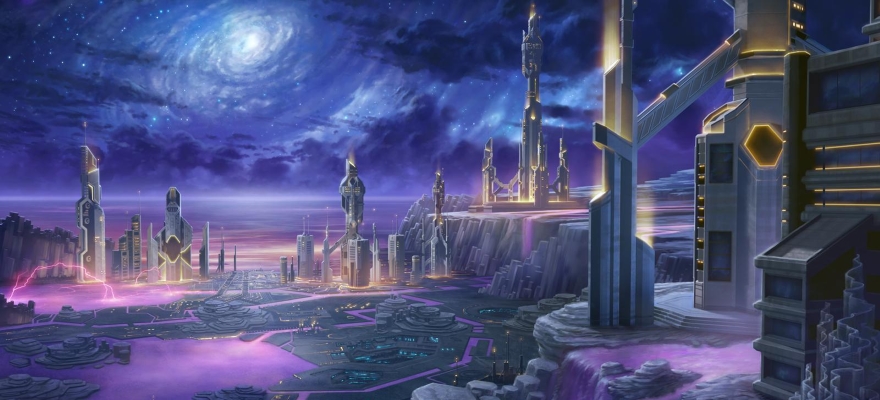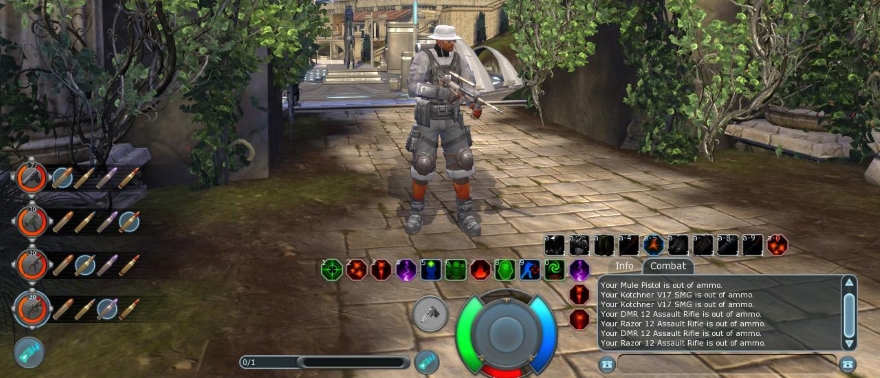
In 1994, a science-fiction movie called Stargate took the idea of alien portals that allowed people to travel instantaneously across the universe and turned it into a modest success. The notion (and box office gross) was sufficiently interesting enough to be reworked into a hit television series that then became a major franchise.
Stargate SG-1 ran from 1997 to 2007, and was soon spun off into Stargate Infinity (2002-2003), Stargate Atlantis (2004-2009), Stargate Universe (2009-2011), and a pair of direct-to-DVD sequels in 2008. Books, video games, amusement park rides, and even a pinball machine spawned from this series, which by the mid-2000s had a sizable crop of very loyal fans.
So why not an MMORPG? The popularity of the IP would help bolster interest in the game, and the idea of hopping across the galaxy to different planets went hand-in-hand with the virtual world setup of MMOs. In 2006, at the height of Stargate’s fame, work began on such a game — work that would soon enough lead to ruin and heartbreak. This game was Stargate Worlds.
 Stargate open
Stargate open
The joyous announcement came in February 2006 that Cheyenne Mountain Entertainment was indeed working on creating a massively multiplayer game in the Stargate universe using a modified Unreal Engine 3.
According to the announcement, “Stargate Worlds is an MMO that provides players with a form of exploration, adventure, and ranged combat set in worlds of historical human time periods, alien environments, and outer space locations. Players will travel through the Stargate as a team of soldiers and scientists where they can forge alliances, establish trade, investigate ancient mysteries, and defend Earth from such hostile forces as the Goa’uld and the Ori in an immense multiplayer universe.”
MGM had signed the license over to CME back in 2005, and by November of the next year, production was in full swing. The devs were coy about the number of planets slated for launch, but a poll revealed that at least six were being made. The title became immensely popular as a prospective MMO, winning at least one award at E3 in 2006.
Cheyenne Mountain Entertainment’s team had ballooned to 100 employees by 2008, some of which had come from other MMO studios such as Blizzard. There was even talk of a second, unnamed MMO in development as well.
By the latter half of 2008, it looked as though it was really going to happen, although not by the original target date of Q4 of that year as was previously mentioned by the studio. Hundreds of thousands of fans signed up for a chance at a beta key. Stargate Worlds launched its first closed beta test, an event that was experienced by at least some of Massively OP’s readers. However, dark whispers of cash flow problems started to crop up, leaving the future of this yet-to-be-born title in doubt…
Stargate explored
To the devs’ credit, there was an attempt to not merely mimic a World of Warcraft-type class system that pervaded the industry at the time, but feature archetypes that eschewed a strict holy trinity setup for more flexible roles. These ranged from the non-combat Archaeologists (who would be more involved in puzzle-solving) to the heavy melee hitter Jaffa. The devs promised that there would be quests for each of the professions, although how involved that would have been remained to be seen.
All of the major races from the show would’ve been represented, along with one or two that were hinted at but never seen. The devs touched on how players would be able to make long-term choices for their character’s development based on the race they selected.
There was discussion about how non-combat classes could participate in fights, such as the Archaeologist distracting mobs through a minigame to the point where the mob despawned without dying. There were also minigames planned for hacking, all of which could be farmed off by players who didn’t want to do it to those who did.
Players wouldn’t have rushed to the cap and sat there bored, either. Plans were in place to raise the level cap by two every few months along with an influx of new content and stories. Enemies were designed to be a little more unpredictable, with AI that would change behaviors depending on whether the mob was aggressive, defensive, or something else entirely. And fighting would have required players to use more military-style tactics than normally seen in MMOs.
Travel between worlds would be accomplished, naturally, by stargate, although the devs said that spaceships weren’t out of the question for areas not linked by the gate network.
And years before “transmedia synergy” became the catchphrase of Defiance, Stargate Worlds was already planning on intertwining its online missions with the stories being told by the shows. Even an Atlantis expansion was rumored to be on the drawing board. Interestingly enough, the television’s showrunners publicly stated that the MMO’s stories would carry just as much weight in the franchise’s canon. The stories would’ve been pushed forward with the help of live events, of which the devs were major fans.
“One of the goals that we both have once the game launches and we’re up and running, is to co-tell stories about stuff that’s happening in the show, talking about it in the MMO world and vice-versa,” Creative Director Chris Klug said in 2008.
Stargate closed
Rumors of problems swirling about Stargate Worlds started to become solid news by 2008. Cheyenne employees reportedly were denied pay, even as the game prepared to enter into its second beta test the following year.
Two-thousand and nine didn’t see a brighter tomorrow for the game, however. Its head developer jumped ship to Gazillion, CME struggled to pay its bills, and efforts were shifted from the MMO to a new shooter game set in the same universe. The studio shifted into damage control mode, insisting that work was still being done and that it had obtained enough funding to finish the MMO. This was later revealed to be not the case at all, but a blatant lie told to mislead investors.
Even while fans started to get an inkling that Stargate Worlds was struggling in development, there was still hope that the game would somehow make it to the finish line and release. Even the pilot episode of Stargate Universe in 2009 showed a character playing a thinly disguised beta of Stargate Worlds as a teaser for the faithful. FireSky, a CME company, moved in to take the role as the game’s publisher in April.
These hopes were cruelly dashed to the ground in February 2010, as word got out that CME had not only filed for Chapter 11 bankruptcy but was scrambling to distance itself from former CEO Gary Whiting. The kicker is that this news came just days after CME had released Stargate: Resistance, a spin-off shooter that focused on PvP and was an obvious attempt to scurry up some cash and keep the fires of fandom alive for the promised MMO.
A month later, in March 2010, Cheyenne Mountain Entertainment went into receivership. Employees created new companies to handle the assets (Fresh Start) and well as one to operate Stargate: Resistance (Dark Comet Games). The latter kept that title running until January 2011 (it was later resurrected by fans). Cheyenne and MGM commenced in a legal battle for the assets to Stargate Worlds, a suit that ended in a draw of sorts: Cheyenne got most (but not quite all) of the assets while MGM terminated the IP license for the game.
Even through all of this, fans created a website in an attempt to save the game from a final doom. It was ultimately for naught, however. The game settled into its early grave as CME slipped away for good in November 2010, and the legal ramifications shambled on. Gary Whiting and other CME execs were the target of multiple lawsuits, some as recently as 2012.
Considering how very close Stargate Worlds came to launching, it’s a digital tragedy of the highest order that it never came to be. Did you get a chance to test this game? Let us know your experiences in the comments!
 Believe it or not, MMOs did exist prior to World of Warcraft! Every two weeks, The Game Archaeologist looks back at classic online games and their history to learn a thing or two about where the industry came from… and where it might be heading.
Believe it or not, MMOs did exist prior to World of Warcraft! Every two weeks, The Game Archaeologist looks back at classic online games and their history to learn a thing or two about where the industry came from… and where it might be heading.















